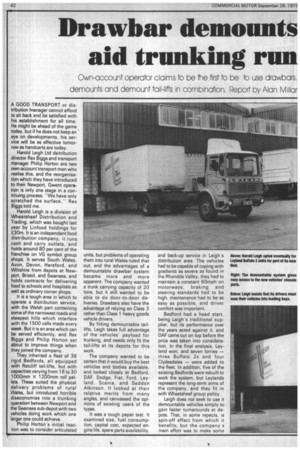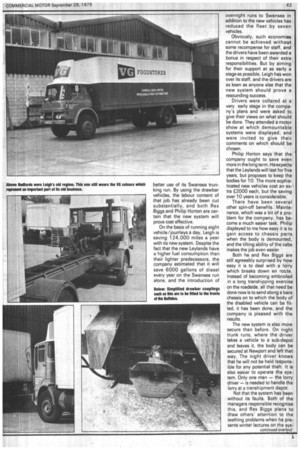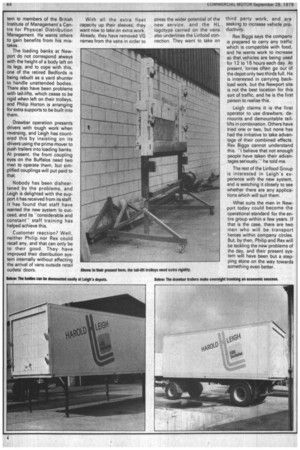Drawbar demounts aid trunking run
Page 44

Page 45

Page 46

If you've noticed an error in this article please click here to report it so we can fix it.
Own-account operator claims to be the first to be to use drawbars, demounts and demount tail-lifts in combination, Report by Alan Millar
A GOOD TRANSPORT or distribution 'manager cannot afford to sit back and be satisfied with his establishment for all time. He might be ahead of the game today, but if he does not keep an eye on developments, his service will be as effective tomorrow as handcarts are today.
Harold Leigh Ltd dsitribution director Rex Biggs and transport manager Philip Horton are two own-account transport men who realise this, and the reorganisation which they have introduced
to their Newport, Gwent operation is only one stage in a continuing process. -We have only scratched the surface," Rex Biggs told me.
Harold Leigh is a division of Wheatsheaf Distribution and Trading, which was bought last year by Linfood holdings for £30m. It is an independent food distribution company, it runs_ cash and carry outlets, and holds around 80 per cent of the franchise on VG symbol group shops. It serves South Wales, Avon, Devon, Hereford, and Wiltshire from depots at Newport, Bristol, and Swansea, and holds contracts for delivering food to schools and hospitals as well as ordinary corner shops.
It is a tough area in which to operate a distribution service, with the Welsh part containing some of the narrowest roads and steepest hills which interfere with the 1 500 calls made every week. But it is an area which can be served efficiently, and Rex Biggs and Philip Horton set about to improve things when they joined the company.
They inherited a fleet of 36 rigid Bedfords, all equipped with Ratcliff tail-lifts, but with capacities varying from 18 to 30 1000mm X 1200mm roll pal lets. These suited the physical delivery problems of rural Wales, but introduced horrible diseconomies into a trunking operation between Newport and the Swansea sub-depot with two vehicles doing work which one larger one could achieve.
Philip Horton's initial reaction was to consider articulated units, but problems of operating them into rural Wales ruled that out, and the advantages of a demountable drawbar system became more and more apparent. The company wanted a trunk carrying capacity of 20 tons, but it still wanted to be able to do door-to-door deliveries. Drawbars also have the advantage of relying on Class 3 rather than Class 1 heavy goods vehicle drivers.
By fitting demountable taillifts. Leigh takes full advantage of the vehicles' payload for trunking, and needs only fit the tail-lifts at its depots for this work.
The company wanted to be certain that it would buy the best vehicles and bodies available, and looked closely at Bedford, DAF, Dodge, Fiat, Ford, Ley land, Scania, and Seddon Atkinson. It looked at their relative merits from many angles, and canvassed the opinions of existing users of the types.
It was a tough paper test. It examined size, fuel consumption, capital cost, expected engine life, spare parts availability, and back-up service in Leigh's distribution area. The vehicles had to be capable of coping with gradients as severe as found in the Rhondda Valley, they had to maintain a constant 60mph on motorways, braking and steering standards had to be high, maintenance had to be as easy as possible, and driver comfort was important.
Bedford had a head start, being Leigh's traditional supplier, but its performance over the years acted against it, and DAF came out on top before the price was taken into consideration. In the final analysis. Leyland won, and seven lorries — three Buffalo 2s and four Clydesdales — were added to the fleet. In addition, five of the existing Bedfords were rebuilt to work the system, but Leylands represent the long-term aims of the company, and they fit in with Wheatsheaf group policy.
Leigh does not seek to use it demountable vehicles simply to gain faster turnarounds at depots. That, in some repects, is spin-off effect from which it benefits, but the company's main effort was to make some
Above: Befffords were Leigh's old regime. This one still wears the VG colours which better use of its Swansea trun represent an important part oi ils aid business. king run. By using the drawbar
vehicles, the labour content of that job has already been cut substantially, and both Rex Biggs and Philip Horton are certain that the new system will prove cost effective.
On the basis of running eight vehicle/journeys a day. Leigh is saving 124,000 miles a year with its new system. Despite the fact that the new Leylands have a higher fuel consumption than their lighter predecessors, the company estimated that it will save 6000 gallons of diesel every year on the Swansea run alone, and the introduction of
overnight runs to Swansea in addition to the new vehicles has reduced the fleet by seven vehicles, Obviously, such economies cannot be achieved without some recompense for staff, and the drivers have been awarded a bonus in respect of their extra responsibilities. But by aiming for their support at as early a stage as possible, Leigh has won over its staff, and the drivers are as keen as anyone else that the new system should prove a resounding success.
Drivers were collared at a very early stage in the company's plans and were asked to. give their views on what should be done. They attended a motor show at which demountable systems were displayed, and were invited to give their comments on which should be chosen.
Philip Horton says that the company ought to save even more in the long term. Heexpects that the Leylands will last for five years, but proposes to keep the bodies for 10. The more sophisticated new vehicles cost an ex-' tra £2000 each, but the saving over 10 years is considerable.
There have been several other spin-off benefits. Maintenance, which was a bit of a problem for the company, has become a much easier task. Philip displayed to me how easy it is to gain access to chassis parts when the body is demounted, and the tilting ability of the cabs makes the job even easier.
Both he and Rex Biggs are still agreeably surprised by how easy it is to deal with a lorry which breaks down en rot,ite. Instead of becoming embroiled in a long transhipping exercise on the roadside, all that need be done now is to send along a bare chassis on to which the body of the disabled vehicle can be fitted, it has been done, and the company is pleased with the results.
The new system is also more
secure than before. On night trunk runs, where the driver takes a vehicle to a sub-depot and leaves it, the body can be secured at Newport and left that way. The night driver knows that he will not be held responsible for any potential theft. It is also easier to operate the system. Only one man — the lorry driver — is needed to handle the
lorry at a transhipment depot. Not that the system has been
without its faults. Both of the managers responsible recognise this, and Rex Biggs plans to draw others' attention to the teething problems when he presents winter lectures on the sys
tern to members of the British Institute of Management's Centre for Physical Distribution Management. He wants others to gain benefits from his mistakes.
The loading banks at Newport do not correspond always with the height of a body left on its legs, and to cope with this, one of the retired Bedfords is being rebuilt as a yard shunter to handle unattended bodies. There also have been problems with tail-lifts, which cease to be rigid when left on their trolleys, and Philip Horton is arranging for extra supports to be built into them.
Drawbar operation presents drivers with tough work when reversing, and Leigh has countered this by insisting on its drivers using the prime mover to push trailers into loading banks. At present, the front coupling eyes on the Buffalos need two men to operate them, but simplified couplings will put paid to that.
Nobody has been disheartened by the problems, and Leigh is delighted with the support it has received from its staff. It 'has found that staff have wanted the new system to succeed, and its -considerable and constant" staff training has helped achieve this.
Customer reaction? Well, neither Philip nor Rex could recall any, and that can only be to their good. They have improved their distribution system internally without affecting the arrival of vans outside retail outlets' doors. With all the extra fleet capacity up their sleeves, they want now to take on extra work. Already, they have removed VG names from the vans in order to stress the wider potential of the new service, and the HL logotype carried on the vans also underlines the Linfood connection. They want to take on third party work, and are seeking to increase vehicle productivity.
Rex Biggs says the company is prepared to carry any traffic which is compatible with food, and he wants work to increase so that vehicles are being used for 12 to 16 hours each day. At present, lorries often go out of the depot only two thirds full. He is interested in carrying backload work, but the Newport site is not the best location for this sort of traffic, and he is the first person to realise this.
Leigh claims it is the first operator to use drawbars, demounts and demountable taillifts in combination. Others have tried one or two, but none has had the initiative to take advantage of their combined effects, Rex Biggs cannot understand this. "I believe that not enough people have taken their. advantages seriously," he told me.
The rest of the Linfood Group is interested in Leigh's experience with the new system, and is watching it closely to see whether there are any applications which will suit them.
What suits the men in Newport today could become the operational standard for the entire group within a few years. If that is the case, there are two men who will be transport heroes within company circles. But, by then, Philip and Rex will be tackling the new problems of the day, and their present system will have been but a stepping stone on the way towards something even better.




























































































































































